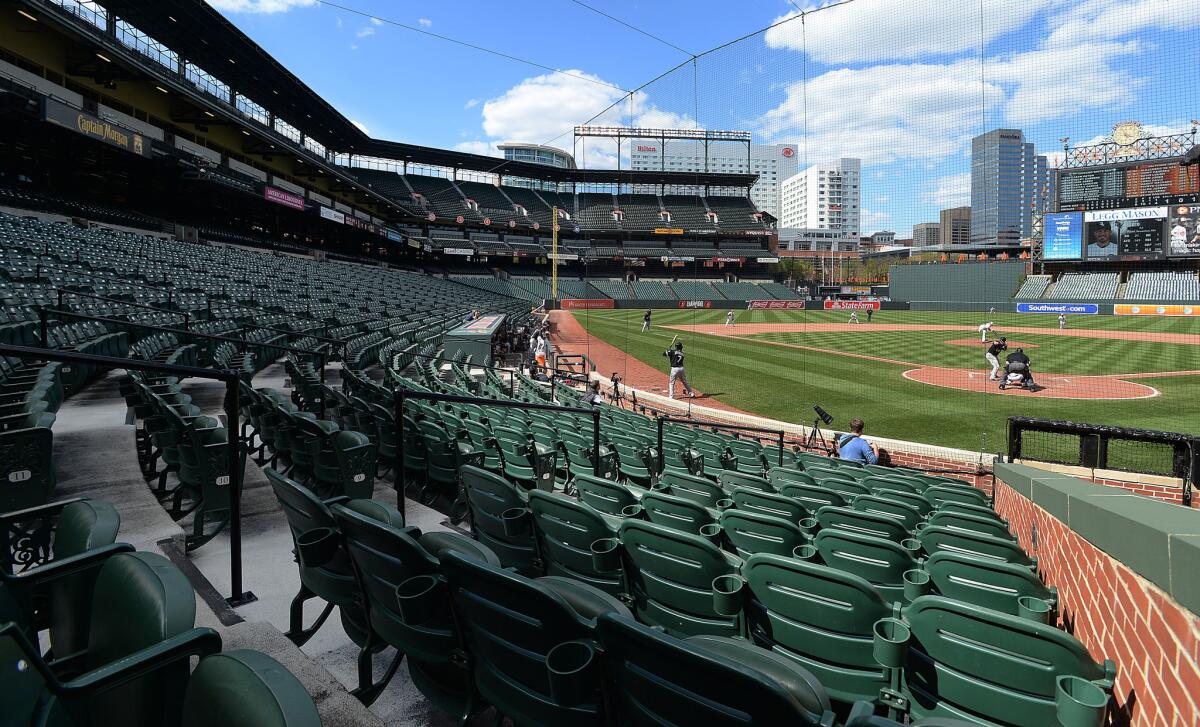Orioles-White Sox game: Baltimore’s urban stadium becomes no-fans’ land

- Share via
The whiteboard in the Camden Yards press box listed some details about the Baltimore Orioles’ fourth home date of the season, a Wednesday afternoon game against the Chicago White Sox.
Temperature: 73F.
First pitch: 2:06.
Attendance: 0.
With protests and unrest roiling Baltimore following the Monday funeral of 25-year-old Freddie Gray, who died in police custody earlier this month, the Orioles and Major League Baseball chose to play a scheduled game on Wednesday but keep ticket holders out.
The resulting images — section after empty section of dark-green seats — were a reminder that the sport’s move over the last 25 years back into urban centers, with downtown baseball-only ballparks replacing multisport concrete bowls, also put stadium architecture and city life back into a kind of dialogue.
That dialogue has always been more strained than the architects of those stadiums, or major-league owners, have been eager to admit. Baseball is a game played more and more by athletes from the suburbs and Latin America and less and less by kids from U.S. cities. The number of African American major leaguers has declined from roughly 20% 30 years ago to about 8% today.
The growing estrangement of the sport from the black community became inextricable from architectural symbolism on Wednesday. It was like a scene from a movie not about urban unrest but about a viral epidemic — the stadium under quarantine, hermetically sealed from the city and its dangers.
It didn’t help that the team chose to play John Denver’s 1974 hit “Thank God I’m a Country Boy” during the seventh-inning stretch, as is customary at Camden Yards. This was hardly a home game like every other.
Baseball already is a sport so ruled by tradition that it has trouble looking contemporary culture squarely in the face. The decision by the team, advised by Baltimore police, not to postpone Wednesday’s game or move it to another city played right into that stereotype.
Oriole Park at Camden Yards, to use its official name, was the first of the new generation of downtown stadiums. Somewhat incongruously, these ballparks tend to combine nostalgic design touches like red brick with locations in urban centers in need of a boost of investment and tourist spending.
Designed by the architecture firm HOK Sport, now called Populous, Camden Yards was therefore a throwback trailblazer, a pioneer in old-fashioned clothing. It opened in spring 1992 as part of a larger effort to revitalize Baltimore’s Inner Harbor.
I saw the ballpark once when it was empty — even emptier than on Wednesday. In February 1993, tired of another endless northeast winter during my senior year of college, I got in my car and headed south on I-95 toward Miami. In the morning, having driven through the night, I stopped off in Baltimore to see the new stadium. I found a couple of unlocked gates and slipped inside.
I shivered as I looked around. It was easy to picture the stadium a few months later, on a warmer day, full of fans in T-shirts. But for the moment I was the only one there.
In a way that experience was not so different from the one I’d have years later as an architecture critic. I often see buildings now just before they open to the public, while they’re still empty.
What happened on Wednesday in Baltimore was not the same. It was a reversal of the natural order of things in architecture, which says that buildings are empty before they open and full later on, and that baseball stadiums are quiet on February mornings and crowded on April afternoons.
More to Read
The biggest entertainment stories
Get our big stories about Hollywood, film, television, music, arts, culture and more right in your inbox as soon as they publish.
You may occasionally receive promotional content from the Los Angeles Times.











